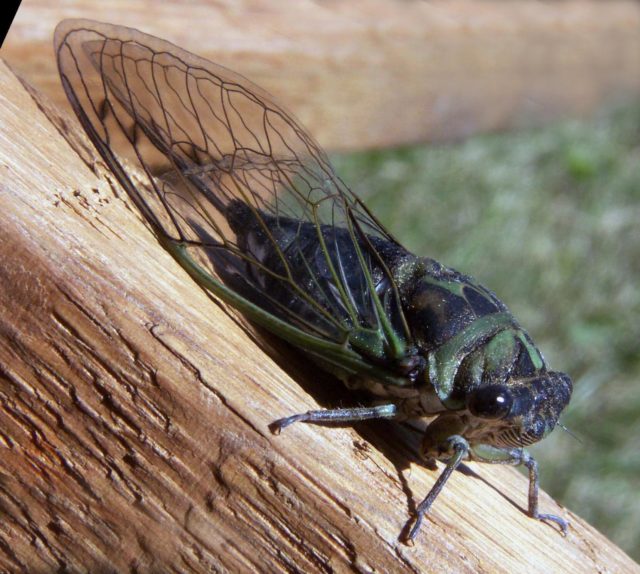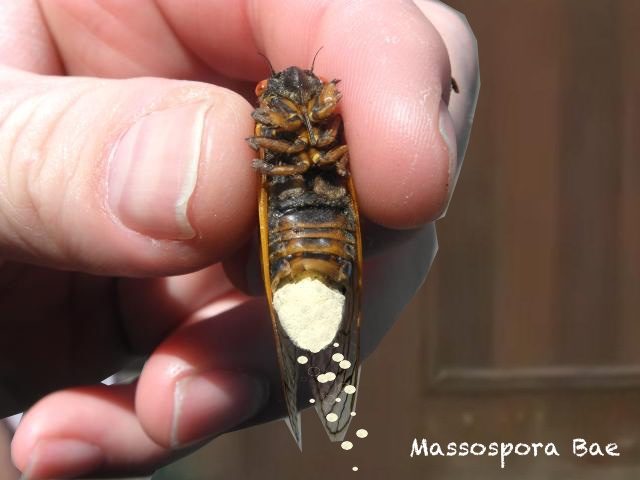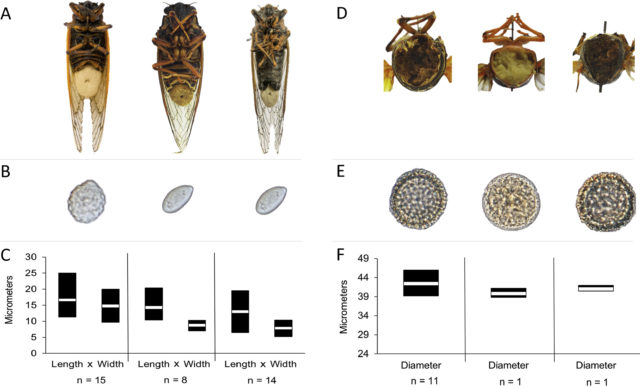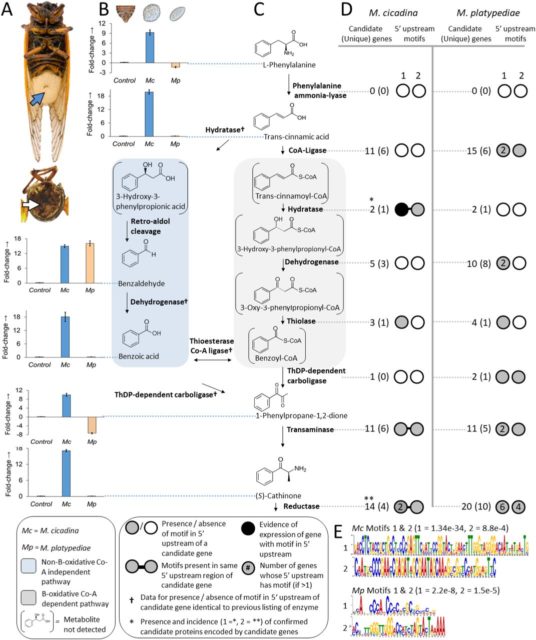Sex, drugs and rock & roll, cicada style

The cicadas are part of the soundtrack of summer. Their calls, especially if a large number of animals is gathered, can form an impressive concert. They are part of the hemiptera, the order of aphids and bedbugs, but they do not have the bad reputation of these others, although they are not beneficial either. The hemipterans have modified mouth parts forming a peak-shaped structure called rostrum, which is adapted to pierce barriers and suck liquids, sap in plants or blood in animals. The hemiptera are hemimetabole insects, that is to say, with incomplete metamorphosis; after hatching from the egg, nymphs emerge, which are immature stages similar to adults but without gonads or wings. After several molts, which originate up to five successive nymphal stages, they become imagos (adults), winged, with the reproductive apparatus complete and sexually mature, ready to mate and perpetuate their species.
The cicadas that sing are the males and the sound is produced by a stridulatory apparatus located at the beginning of the abdomen and consisting of chitinous membranes called tymbals and air sacs that act as sounding boards. An authentic biological musical instrument. The females hear these sounds with auditory organs located in the thorax and respond to the call of the romeo that has the strongest sound and maintains it for a longer time, an indirect demonstration of good genes.
The cicadas are dispersed using their wings in search of a mate. The mating takes place generally during the warm months, although the time varies according to the species and the region. Several species mate in a same time what produces a peculiar sonorous phenomenon, a competition to impose its melody. The males attract the females with the song and the females flapping their wings. Once fecundated, the female makes a V-shaped cut in the bark of the tree and puts about 600 eggs there. Finally after two-six weeks of deafening songs, mating and egg laying, the cicadas die and the process, that wonderful process we call life, begins again.
After hatching from the egg, the new generation begins its feeding in the aerial part of the tree but the nymphs fall to the ground and penetrate the land, where they live buried from two to seventeen years, depending on the species. There, buried, they feed on the sap of the tree, piercing the roots with their sucking mouthparts. At the end of that time, they emerge from the ground as if they were revived dead coming from the grave, climb the tree, suffer a final metamorphosis, become adults with wings and genitals developed ready for mating and feed on the sap of the plant, now again in the aerial parts. In 2016 billions of cycads emerged from the ground in the northeast of the United States.
This is the normal life of a cicada, much more laborious than suggested by the famous fable originally written by Aesop and recreated by Jean de La Fontaine and Félix María Samaniego. I did not like the fable when I read it as a child. With the arrival of winter, the cicada asked the ant for help, but the ant recriminated her lazy summer and denied her the necessary food to survive. The ant seemed vengeful, insensitive and cruel to me like those miserable sanctimonious people who rejoice when something bad happens to the happy and dissolute neighbor, and above they boast of morality and charity.

There can also be masters and slaves here. The biological cycle of the cicada becomes complicated if it is infected. Massospora is a parasitic fungus that also awaits its moment. It is a zygomycete specialized in cicadas. When a nymph digs in a soil where this fungus exists, the spores stick to its body. As the cicada matures, the massospora multiplies, devours the insect from within, castrates it and replaces its abdominal area with a whitish mass of spores, which is known as a fungal plug or pustule. And then, Massospora takes control 12.
Massospora is therefore part of that list of parasites that include viruses, bacteria, nematodes, protists, crustaceans and fungi that modulate the behavior of their hosts to increase their transmission and improve their dissemination. The process seeks the active transmission of the host and is a behavior where the fungus maintains or accelerates a normal activity of the host at the same time that advances in sporulation, although the state of the insect is tremendously precarious. The cicada is devastated, its soft tissues stuffed with hyphae of the fungus, its sexual organs destroyed and, despite all this, with its last throes of life, it launches into a wild sexuality. Infected cicadas become hyperactive and hypersexual. The insect tries to mate with the same vigor although its sexual organs no longer exist, although it hardly has muscles or nervous system but in those last movements it passes to the mate part of the spores of massospora spreading the infection. The more cicadas become infected, the greater the biological success of the fungus. In addition, in the intense movements of the copula, the spores of the fungus fall to the ground and thus the soil is seeded. The process is ready to start again when the nymphs of the new generation fall from the tree and begin to dig.

Most fungi that infect insects kill their host before producing the conidia that generate the spores that will give rise to new fungi. A few species keep their hosts alive while sporulating, which helps to disperse the spores. Massospora is one of them. There are many amazing things in this process. How is the cicada able to continue functioning, to keep flying, to make sounds when two thirds of its body have been substituted by the hyphae of the fungus? Why does a single behavior prevail, the sexual one? How does the fungus control the insect? Many mushrooms have a spore dispersal system that we call mushrooms. The fungus lives buried or on the surface of the soil but when it reaches favorable conditions, temperature, humidity, etc. the hyphae join in a reproductive body that rises from the ground. The spores that will generate new fungi will fall from the lamellae or cavities of the mushroom. But Massospora uses another system, its system of spreading spores is not a mushroom but the cicada, which disperses and infects the fungus when it mates, as an authentic sexually transmitted disease.
But the cicada is on the verge of death, eaten by the fungus, crammed with spores, how does Massospora get the insect to ignore the damage in his body and continue devoting himself to mating? Matthew Kasson, an American mycologist, and his group considered how the fungus could manipulate the behavior of the cicada and presented a hypothesis: through psychoactive substances (1). We all know that some mushrooms are capable of generating drugs that have been consumed in rituals directed by shamans over millennia. Kasson and his group collected cicadas and analyzed the chemical composition of the spore packets. The surprise was that they contained psilocybin and cathinone, two molecules that are included in schedule 1 of the Administration against drugs of the United States, the famous DEA. Schedule 1 drugs are most powerful, most addictive, without medical use and potentially most dangerous. In fact, the researchers alerted the DEA, which authorized them to continue with their investigation.

Massospora cicadina infects periodic cycads, which arise every 13 or 17 years, and causes them to contain cathinone. Massospora platypediae and Massospora levispora infect annual cycads, which emerge every year, and cause them to present psilocybin. Cathinone is an amphetamine, and is found only in khat or qat, a plant that is consumed in East Africa and the Arabian Peninsula. The qat is a vegetable stimulant that is chewed and is the plant with the most potent psychostimulant properties known to date. This drug produces a stimulation of the Central Nervous System and generates a sensation of stimulation and euphoria at the psychic level.
Psilocybin is the hallucinogen that is part of magical fungi. It is a prodrug alkaloid of a hallucinogenic compound: psilocin, responsible for the psychoactive effect of the drug. Mushrooms that possess psilocybin have been used as entheogenic substances, as a way to contact divinity. The shaman consumed the mushroom as a way to transcend, to communicate with the gods, to guide the future of his people. Then, in the twentieth century they became part of the wide panoply of recreational drugs, consumed for sheer pleasure. It is produced by around 200 species of fungi and also manufactured chemically since the Swiss chemist Albert Hofmann discovered the synthesis route. This is the first time that psilocybin is found in the Animal kingdom.
At first the group assumed that Massospora synthesized these drugs following the same metabolic pathways that follow the khat and magic mushrooms. But a genomic analysis revealed that Massospora does not have the enzymes to make those synthetic processes. It is possible that the synthetic mechanism is a symbiotic association between the insect, the fungus and the microbiota of the digestive tract of the insect, and that this cooperation between such different species is responsible for this mini-laboratory of drugs. And another question, could you use the infected cicadas to get a high yourself? The problem is that both drugs are two of the almost 100 chemical compounds detected in these cicadas. It is possible that some of them are toxic to humans. It certainly sounds too risky (2).
These molecules are used as recreational drugs for their properties to alter the mind, as stimulants but also have a medical use. They can be used to treat obesity because they decrease appetite. Psilocybin has been studied as a drug for depression and anxiety in cancer patients while cathinone is added in anti-attention deficit hyperactivity medication because it improves concentration.
The cicadas that had been infected as nymphs had much higher amounts of the two narcotics than the less active cicadas that became infected in adults while copulating. The males try to copulate with everything they find and in some cases they behave like females, beat their wings instead of singing with what they attract other males and, therefore, help to disperse the fungus. The obsession with copulation, something that the drugs achieved, maximized the dispersion of the spores in those cicadas that became infected when they were nymphs. Is it possible that some microorganisms alter our behavior so that we are more promiscuous or less careful with protective measures? It is possible that there are some microbes that are sexually transmitted 3. For that, it is important that the host does not appear ill and, in fact, many sexually transmitted diseases such as chlamydia or gonorrhea are frequently asymptomatic. Sexuality, and even promiscuity, could be a system to achieve a greater microbiological variety, including beneficial species. There may even be some species of sexually transmitted microbes that encourage humans to have sex more often. A very simple possibility is that sex is more pleasant and an easy way is a microbe that increases vaginal mucus. As simple as that.
And what are the effects on the cicada of those doses of drugs? At the moment we can only speculate. It is possible that they make cicadas less desirable to predators, many alkaloids are used as repellents for several groups of animals. It is also possible that they encourage a more active behavior, with less fear; It is possible that it slows down the damage caused by the fungus and causes the cicada, with a sensation of well-being chemically generated, to live a normal life in its last hours of life, including that desire for mating. With fungi or without fungi, these animals spend almost two decades underground to finish in a few weeks of pleasure.
References
- Boycea GR, Gluck-Thalerb E, Slot JC, Stajich JE, Davis WJ, James TY , Cooley JR, Panaccione DG, Eilenberg J, De Fine Licht HH, Macias AM, Berger MC, Wickert KL, Stauder CM, Spahr EJ, Maust MD, Metheny AM, Simon C, Kritsky G, Hodge KT, Humber RA, Gullion T, Short DPG, Kijimoto T, Mozgai D, Arguedas N, Kasson MT (2019) Psychoactive plant- and mushroom-associated alkaloids from two behavior modifying cicada pathogens. Fungal Ecology 41: 147-164 doi: 10.1016/j.funeco.2019.06.002 ↩
- Klein JA (2019) Drugged, Castrated, Eager to Mate: the Lives of Fungi-Infected Cicadas. The New York Times ↩
- Wilson N (2015) Surprising benefits of sexually transmitted infections. ↩
1 comment
Thanks to Dr Alonso for a critically interested look at this latest reported discovery, as now published and making the rounds on internet. I appreciate the striking coherence of the spotlight given here to this research.
As manner of discussion goes, that alone poses a refreshing break from a more customary style presentation (tabloid sensationalism) for popular attention I find pervasive – mainly soliciting “special interest” of a psilocybin-minded, subcultural readership.
Thank you Dr Alonso.
In case it’s of remotest interest: following request rec’d (at reddit) I’ve been looking at this research myself critically, from basic fact checking-standpoint under magnification. The more closely I look the less scientifically valid what I see, as meets the eye – appears.
(Again in case it’s of interest to you and/or for your readership): I might quote a single 3-sentence passage from this research in which two lit sources are cited, as an example to spotlight the type problems I find running thru the entire exposition – like a thread of disconnection (unless I’ve misunderstood something?):
(print copy, p. 162):
Relative to the first source cited (Awan et al.) I find 2 glaring discrepancies.
One involves a reversal of direction from source (cited) to sink, in Boyce et al. (2019) theorizing this “protection for a few select insects” [that] “Psilocybin may …. confer.” Fungi were the organisms Awan et al. tried hypothesizing ‘may possibly be protected’ and from insect predation – not the insects (“select few” or otherwise), as Boyce et al. somehow seem to have it.
The other seems a matter of Boyce et al. having turned Team Awan’s reported results upside down for an example of how “psilocybin might …” (etc) – in ‘theoretical’ support of their discovery (as reported). Awan et al. report no such evidence only negative findings, “for example” (a la Boyce et al.) notwithstanding.
However speculatively (as worded) Awan et al. even conclude, as understated: “the hypothesis [psilocybin] is produced as an adaptive defense compound MAY NEED TO BE RECONSIDERED” http://www.biorxiv.org/content/early/2018/07/27/374199.full.pdf
No detectable ‘example’ figures in Awan’s evidence as reported. Nor do Boyce et al. seem to understand research they’ve availed of by the most charitable interpretation I can muster of this double-dip slip.
These problems relate only to the first two sentences, ending in the Awan citation. The 3rd sentence displays ‘double trouble’ too – “Likewise” (as it opens). Again, an apparent misrepresentation of theoretical framework in the cited lit source figures.
This one involves leaf cutter ants (not sciarids) observed gathering a “Psilocybe” species (coprophila) – as Boyce et al. have it “… possibly for defense purposes (Masiulionis et al., 2013)”.’
In fact no “protected by” hypothesizing figures in Masiulionis et al. Their theoretical frame is based in extant knowledge of the ants observed and stands on questions properly adduced – as clearly stated:
“(B)asidiocarp collections by attine ants raises obvious questions relating to the ORIGIN OF FUNGICULTURE.” Masulinonis cite a previously proposed “Consumption First” model of how attine fungiculture may have evolved – with no visible connection, express or implied, to any ‘defense’ line as cast (by Boyce et al.).
But the most glaring problem in this 3 sentence train wreck (as I find it) involves the ‘psilocybin’ mushroom species observed by Masiulionis – on which Boyce et al. have their 2nd example of evidence staked out (“likewise” lending ‘support’ to this “possible protection by” narrative) – “Psilocybe” coprophila.
First of all “Psilocybe” coprophila contains no psilocybin – as might logically seem necessary for ‘hypothesizing’ purposes made of it by Boyce et al.
Second, “Psilocybe” coprophila is not even a Psilocybe. Except in former nomenclature obsolete since 2013. Boyce et al. resurrect a ‘usefully’ antiquated binomial, apparently for special purpose of posing – Deconica coprophila, this species’ correct name and classification – as a Psilocybe.
As if so doing renders it an example – “likewise” – of a mushroom with psilocybin ‘possibly protecting’ certain insects.
The seemingly ‘all hole, no cheese’ analysis of this 3-sentence specimen merely samples results of independent reddit-posted review proceeding that began Mar 21, 2019 @ preprint stage) by ‘doctorlao’ – at request of a colleague who collaboratively assisted by providing hyperlinks, questions, reflections and counter-points. In case of further interest, google (two threads by title):
AND
With good regards to Dr A